

AN ARTIST'S JOURNAL
Edited and prepared for the Internet by Ronald Davis
Remembering Bier Ante Ris'ten
from Lappland
from Lappland
Bier Ante Ris'ten, a Saami woman and reindeer herder in Norwegian Lappland, is remembered with gratitude and appreciation in Roseman's journal. Ris'ten encouraged the artist in his work in Lappland and introduced him to members of her family, who kindly gave of their time to sit for portrait paintings as did Ris'ten herself.
Stanley Roseman's interest in the nomadic Saami took the artist and his colleague Ronald Davis in 1976 beyond the Arctic Circle to the windswept tundra in the interior of Norwegian Lappland. There Roseman painted a series of critically acclaimed portraits of the Saami, an independent, reindeer-herding people who maintain their centuries-old, nomadic way of life in one of the earth's harshest environments.
"The Saami paintings are magnificent."
- The Times, London
Bier Ante Ris'ten, 1976
Lappland
Oil on canvas, 98 x 80 cm
Collection of Ronald Davis
Lappland
Oil on canvas, 98 x 80 cm
Collection of Ronald Davis
From Roseman's journal:
Lappland, also spelled Lapland, the ancestral home of the Saami, or Lapps, comprises northern Norway, Sweden, Finland, and the Kola Peninsula of Russia. Roseman and Davis left the coastal town of Tromsø and drove some 400 kilometers on the one main road that led them east through Norway and into Finland, from where they travelled southeast before turning north to recross the Norwegian border and continue on to the rural township of Kautokeino, situated just above the 69th parallel.
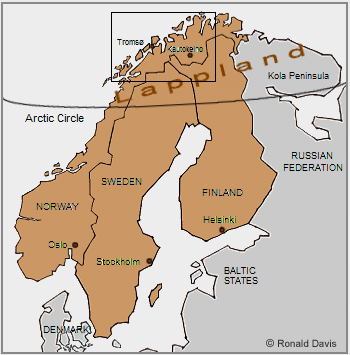
"I became interested in the nomadic Saami as a subject for my work. The Saami are descendents of a hardy, hunting and gathering people who lived in the northern extremity of Europe and were recorded as early as 98 A.D. by the Roman historian Tacitus.[1]
"During the spring and summer of 1976, I did research in libraries and bookstores in New York City in preparation for my prospective work. Ronald, who was overseeing the national tour of The Performing Arts in America exhibition,[2] assisted me in planning the project, charting an itinerary, and deciding where would be our ultimate destination in Lappland.
"Our immediate and most important concern, however, upon which everything depended, was being able to finance the project. Anticipated costs would include art materials, transatlantic and regional transportation, meals, lodgings, and supplies for a planned time period of six to eight weeks. The Performing Arts in America exhibition was having a successful tour and, fortunately, generated purchases of my paintings and drawings that would make the project in Lappland possible.
''Leaving New York City that September, I felt a kinship with Gauguin, who had left a great metropolis and flourishing art center, Paris, to seek inspiration for his work among a group of people living in a remote part of the world - for him, native Tahitians, in the South Pacific; for me, nomadic Saami, beyond the Arctic Circle.
''But once there, would I meet individuals willing to sit for a portrait as the Saami are a mobile people who follow the seasonal migrations of the reindeer from elevated pastures along the seacoast in spring and summer to the bleak tundra, where October snowfalls announce an early winter and daylight hours diminish with increasing rapidity."
7. Bier Ante Ris'ten (left); Davis (center), carrying the artist's paint box and portable easel; and Roseman (right), carrying his canvases and bag of painting supplies, as they prepare to cross the river in a rowboat with Myrdene Anderson, An'te Niilas, Ris'ten's brother, and two herding dogs. Kautokeino, 1976.
5. Myrdene Anderson (left) and Stanley Roseman (right) collecting brushwood and twigs with which to build a smokey fire to signal Ris'ten's brother to arrive in his rowboat to transport his sister and her group across the Cábardasjohka River. Kautokeino, 1976.
6. Ris'ten stands near the smokey fire by the river's edge and waits for her brother to arrive in his rowboat. Kautokeino, 1976.
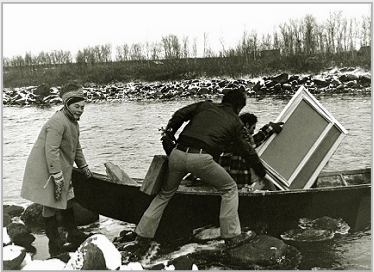
Photo courtesy
Myrdene Anderson
Myrdene Anderson
Lappland
In the last quarter of the twentieth century, the Saami, a numerically small, indigenous minority, accounted for less than one percent of the population in Norway, Sweden, and Finland. The majority of Saami throughout Lappland have assimilated into the dominant culture and are commonly engaged in farming and fishing as well as other sedentary occupations. Only some ten percent of the Saami are reindeer-herding nomads, whereas in northern Norway the percentage is substantially higher.[3] "It was the inland region of Finnmark County in northern Norway,'' writes Roseman, "specifically the rural township of Kautokeino, to where Ronald and I were en route."
4. Tundra in the rural township of Kautokeino, Finnmark County, northern Norway, 1976.
A Fortuitous Beginning in Kautokeino
A few days after Roseman and Davis arrived in Kautokeino, they chanced upon meeting Myrdene Anderson, today a distinguished anthropologist, botanist, and linguist, who was then, in 1976, completing five years of field work as a graduate student from Yale University. Anderson was enthusiastic about Roseman's interest as an artist in the nomadic Saami. She thoughtfully offered the artist and his colleague to be their guide in helping them become acquainted with the region and the people and very kindly took on the task of translator as Roseman and Davis spoke neither Norwegian nor the Saami language, which belongs to the Finno-Ugric language group.
Bier Ante Ris'ten
"Bier Ante Ris'ten, a very pleasant woman in her forties, was a reindeer herder like her father, Bier An'te. For generations Saami women as well as men have been engaged in reindeer herding. The sharing of such a primary subsistence activity has a precedent in the early history of the Saami, as recorded in the first century by Tacitus who notes that women hunted along with the men.[4] Regarding 'reindeer pastoralism' in Saami society today explains Myrdene Anderson, 'both sexes and virtually all ages traditionally have shared in herding chores. . . .'[5]
"Although Bier Ante Ris'ten and her husband had no children of their own, they were surrogate parents to their teenage nephew An'te Niilas, orphaned as a boy when his mother and father drowned while crossing a river in winter. An'te Niilas was mentally handicapped and somewhat shy; however, he and his canine companion Suzy, a black and white herding-dog, often took a walk to visit Myrdene, who lived nearby. Ron and I invited An'te Niilas to accompany us with Myrdene when we drove into Kautokeino village to buy groceries and other supplies. He enjoyed going into the village with us which included the time we drove to a carpenter's shop to have wooden stretchers built for my canvases.
"Ris'ten, a kind and sensitive women, was encouraging to me in my work and appreciative that I asked to paint a portrait of her nephew. When I asked An'te Niilas if he would like to sit for me, he was excited and happy, and I was deeply touched at how much his being included in my work meant to him.''
"Ris'ten, as I came learn, was a hardworking woman who was dedicated to her family. She made regular trips to see her parents and do domestic chores, which included cooking meals and cleaning their cabin situated on an isolated tract across a river. Ris'ten invited Ronald and me to meet her parents and thoughtfully asked if I would like to bring along my painting materials.
"As Ris'ten's parents did not have a telephone in their cabin, Ris'ten, Myrdene, An'te Niilas, Ron, and I collected brushwood and twigs and made a smokey fire at the edge of the icy water to signal Ris'ten's brother to come to get us in his rowboat. The Cábardasjohka River flowed with a strong current making for a precarious crossing in a crowded rowboat which transported Ris'ten, her brother, An'te Niilas and Suzy, Myrdene and her russet-colored canine companion Run'ne, Ron and me, my paint box, portable easel, travel bag of art materials, and canvases.
"Ris'ten's father, a robust and amiable older man, was waiting for us when we arrived and escorted us inside. He expressed interest in my art materials and portable easel, which made me feel especially welcome. Bier An'te was a wonderful, enthusiastic model whose physiognomy and weathered complexion revealed a long, hard life as a reindeer herder in the harsh Arctic terrain.''
Portrait Paintings of a Saami Family
8. Bier An'te (detail), 1976
Reindeer Herder, Lappland
Oil on canvas, 120 x 120 cm
Collection of the artist
Reindeer Herder, Lappland
Oil on canvas, 120 x 120 cm
Collection of the artist
9. Carrying Roseman's newly painted canvases, Davis (foreground) and Anderson cross a frozen stretch of the Cábardasjohka River. Kautokeino, 1976.
"The newly frozen stretch of river was intimidating to cross. Myrdene cautioned that we should walk in single file at some distance from each other to disperse our collective weight. Taking responsibility for my project in Lappland, I volunteered to venture first across the ice. I walked cautiously and carried a painting and my shoulder bag of supplies. An'te Niilas followed behind me with my box of oil paints and my easel. Farther back, Ronald and Myrdene, each carrying a painting, carefully traversed the frozen stretch of river.
Portrait of Bier Ante Ris'ten
Having painted portraits of Bier An'te, Biret, and An'te Niilas, Roseman asked Ris'ten if she would sit for him so that he could include a portrait of her in his work in Lappland. Ris'ten kindly offered her time to the artist, which resulted in the superb portrait presented here, (fig. 10).
In this beautiful portrait Bier Ante Ris'ten, a soft, northern light illuminates the Saami woman's lovely, oval face. Fluent brushstrokes describe the tunic, bonnet, and shawl, and accents of red and yellow complement the predominant earth colors in the painting. The pyramidal composition gives strength to the presentation of the figure. Ris'ten sits with a hand to her cheek and offers a sympathetic regard as she looks out from the canvas. Roseman writes in his journal:
''Some days later Ris'ten graciously invited Ronald, Myrdene, and me for dinner at her home with her husband and An'te Niilas. That invitation was especially meaningful as the nomadic Saami hold a reserve towards those outside their community and was a thoughtful gesture that affirmed her appreciation of my work. Ris'ten prepared a delicious dinner of reindeer stew, a specialty of the Saami cuisine, and the time we shared together was most memorable.
"My contact with the Saami was an enriching experience for my art and for my life,
more than I had hoped for or could have foreseen
when Ronald and I started out on our journey to Lappland."
more than I had hoped for or could have foreseen
when Ronald and I started out on our journey to Lappland."
- Stanley Roseman
10. Bier Ante Ris'ten, 1976
Lappland
Oil on canvas, 98 x 80 cm
Collection of Ronald Davis
Lappland
Oil on canvas, 98 x 80 cm
Collection of Ronald Davis
For Roseman to accomplish his work in Lappland, he and Davis had to adapt to an unfamiliar environment and overcome challenging physical and climatic conditions. The artist's ability to be mobile, as are the Saami; his empathy with his models; and the resultant paintings earned him respect and admiration. Despite the reserve that the Saami held towards those outside their community, a rapport of trust and understanding was established between the Saami and the artist.
"Strong winds made the crossing all the more hazardous as the canvases caught the wind like the sails of a sailboat. A great concern of ours was to avoid slipping on the river's icy surface with the risk of ruining a painting or falling through the ice. Thankfully we managed to cross safely to the opposite shore."
"I am deeply grateful to Ris'ten for her encouragement of my work, for bringing me into her home and that of her parents', and for sharing with me a part of her family life and the Saami culture."
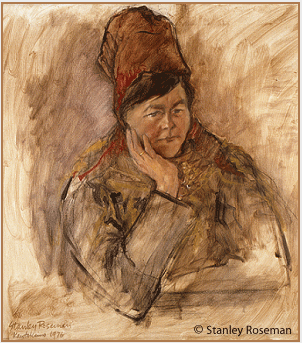
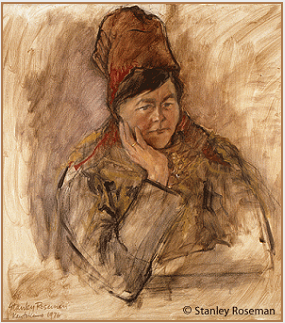
"Ronald and I were renting a cabin in a campsite on the outskirts of the village of Kautokeino, or Guov'dageai'dno, in the Saami language. Each day we drove some twelve kilometers to Myrdene's cottage situated in proximity to several Saami winter dwellings on the windswept tundra in the rural locality of Soaht'tofiel'bmá. Myrdene was very pleasant and interesting to be with, and her conversations were always stimulating on a wide range of subjects. . . . I learned very much from Myrdene about the Saami culture, and I am deeply grateful for her encouragement and enthusiasm for my work.''
Highly respected among the Saami, Anderson thoughtfully introduced Roseman to those whom she felt would be responsive to the idea of sitting for an artist, for the Saami, being a nomadic people, do not have in their culture the tradition of portraiture, particularly life-size, oil on canvas portraits. A friend and neighbor of Anderson was Bier Ante Ris'ten, whose superb portrait is presented at the top of the page and below, (fig. 10), and whom the artist fondly and appreciatively remembers in his journal.
© Stanley Roseman and Ronald Davis, 2014 - All Rights Reserved
Visual imagery and site content may not be reproduced in any form whatsoever.
Visual imagery and site content may not be reproduced in any form whatsoever.
1. Tacitus, Germania, 98 A.D.
2. The American bicentennial exhibition Stanley Roseman - The Performing Arts in America comprised the artist's work on opera, theatre,
dance and the circus. The exhibition, produced by Ronald Davis, opened in December 1975 at the Curtis Institute of Music, Philadelphia;
toured the United States through 1976; and concluded its national tour at the Library and Museum for the Performing Arts, Lincoln Center,
New York City, winter-spring 1977.
3. Myrdene Anderson, "The Saami Reindeer-Breeders of Norwegian Lapland" (American Scientist, Vol. 73, No. 6, November-December,
1985), p. 527.
4. Tacitus, Germania.
5. Myrdene Anderson, "Woman as Generalist, as Specialist, and as Diversifier in Saami Subsistence Activities" (Humboldt Journal of
Social Relations, Vol 10, No. 2, spring-summer 1983), p. 181.
2. The American bicentennial exhibition Stanley Roseman - The Performing Arts in America comprised the artist's work on opera, theatre,
dance and the circus. The exhibition, produced by Ronald Davis, opened in December 1975 at the Curtis Institute of Music, Philadelphia;
toured the United States through 1976; and concluded its national tour at the Library and Museum for the Performing Arts, Lincoln Center,
New York City, winter-spring 1977.
3. Myrdene Anderson, "The Saami Reindeer-Breeders of Norwegian Lapland" (American Scientist, Vol. 73, No. 6, November-December,
1985), p. 527.
4. Tacitus, Germania.
5. Myrdene Anderson, "Woman as Generalist, as Specialist, and as Diversifier in Saami Subsistence Activities" (Humboldt Journal of
Social Relations, Vol 10, No. 2, spring-summer 1983), p. 181.
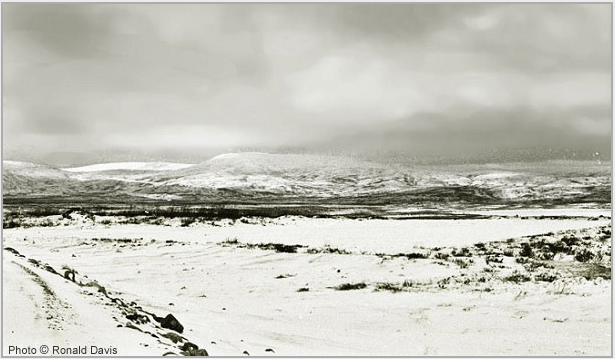
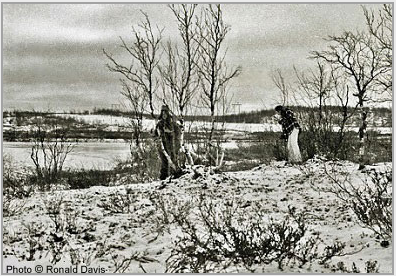
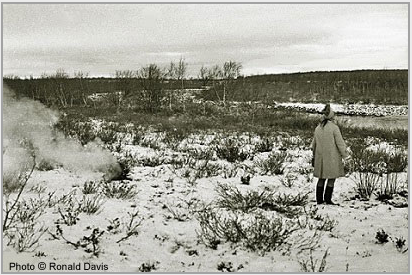
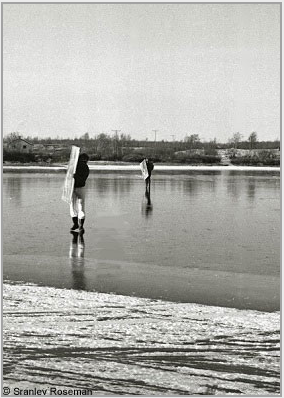
The Journey
The Saami and the Artist
Roseman's Empathy with his Models
An Edition of Drypoint Engravings
The Saami People of Lappland Exhibition at the Peabody Museum, Yale University
The Saami and the Artist
Roseman's Empathy with his Models
An Edition of Drypoint Engravings
The Saami People of Lappland Exhibition at the Peabody Museum, Yale University
Roseman painted two impressive portraits of Bier An'te, as seen above and in the portrait presented on the following page "The Saami People of Lappland." Roseman also painted an excellent portrait of Ris'ten's mother Biret. During the days the artist was at work on his portraits at the home of Ris'ten's parents, the weather grew much colder, and the river froze over. Roseman and Davis' last return from the Saami couple's cabin was made on foot. Ris'ten remained with her parents to finish her chores; An'te Niilas accompanied Anderson, Roseman, and Davis on their return. Roseman recounts:
In this impressive portrait Bier An'te, (fig. 8), Roseman has created a striking composition with a strong presence of the individual and painterly contrasts of materials, textures, and lights and darks.
With lively paint strokes and detail rendering, the artist depicts Bier An'te's voluminous, white reindeer fur coat with red tassel and decorative braiding of red, yellow, blue, and white. The traditional hat from the region of Kautokeino is made with bands of colored braiding and woolen material in tubular forms that emerge from the crown and fall to the back and sides. With a circular leitmotif of braiding and white fur collar, the composition focuses on the face of the Saami reindeer herder of advancing years.
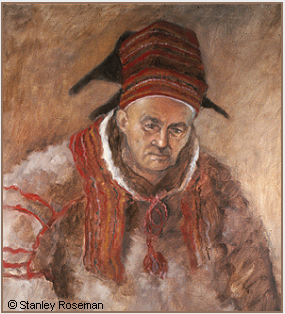
AN ARTIST'S JOURNAL
Remembering Bier Ante Ris'ten from Lappland
An Audience with Pope John Paul II
An Invitation to Draw at the Metropolitan Opera
On Portraiture
